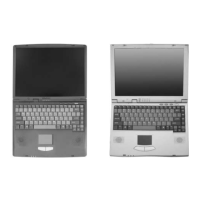
Do you have a question about the Clevo Notebook and is the answer not in the manual?
Guidance on how to handle the notebook computer to ensure its longevity and proper operation.
Instructions for safely handling the power cord and battery pack of the notebook computer.
Guidelines for connecting and using peripheral devices with the notebook computer.
Verify that all items are present and undamaged after unpacking the notebook computer.
Illustrates and describes the top view of the notebook with the LCD display in a closed position.
Illustrates and describes the top view of the notebook with the LCD display opened.
Details on LCD, microphone, LEDs, hot keys, and power button.
Information on keyboard, speakers, trackpad, and power LEDs.
Covers external views and all ports like USB, LAN, serial, parallel, etc.
Details on FDD, CD-ROM/DVD-ROM drives, PC Card Slot, and Infrared Port.
Covers power sources, AC adapter, battery, turning on, and LED indicators.
Instructions for HDD, FDD, CD-ROM/DVD-ROM, and PC Card Slot usage.
Covers hot keys, function keys, and numeric keypad operations.
Overview of power management, ACPI, APM, and setting functions.
Guidelines for battery life, maintenance, and power conservation tips.
Step-by-step instructions for safely removing the notebook's battery pack.
Information on upgrading processor, memory, and HDD, including necessary tools.
Detailed instructions for replacing the existing Hard Disk Drive with a new one.
Instructions for installing new memory modules to expand system RAM.
Guidance on upgrading the computer's processor; contact service representative.
Explanation of BIOS, Power On Self Test (POST) and error messages.
Overview of SCU for setting system parameters, date, time, and power.
Guide to navigating SCU menus, options, and screens.
Steps for partitioning, formatting HDD, and installing Windows 98 SE, Me, and 2000.
Instructions for installing VGA, Audio, LAN, Hot Key, and Modem drivers for various OS.
Solutions for audio issues (no sound, headphones) and battery charging problems.
Troubleshooting for CD, FDD, HDD, PC Card, Power, and Printer problems.
Solutions for hardware installation, LCD panel, microphone, and memory issues.
Details on Processor, Memory, BIOS, LCD, Display, Storage, and Audio.
Specifications for ports, communication, power, size, weight, and environment.